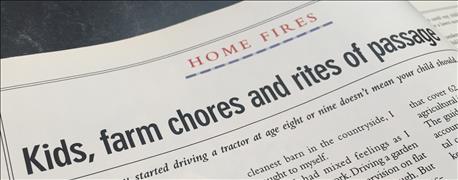October 28, 2016

I cut my teeth as a young farm journalist during the farm crisis of the 1980s, first as a newspaper reporter and then as a Prairie Farmer field editor. Ready to leave the daily newspaper grind after five years, I initially considered a job with a public relations firm in New Jersey.
As part of the PR job interview, I was asked to write an article targeted for Prairie Farmer about Illinois alfalfa farmers and a new alfalfa cubing plant. But a trip to the East Coast and a harrowing drive down the New Jersey Turnpike quickly made me realize big city life wasn’t for me.

HOME FIRES: For many years, Cherry Brieser Stout penned a popular column called Home Fires, where she addressed the family living side of farm life.
Fortuitously, the alfalfa article did land me a job offer with Prairie Farmer in 1988. I spent the next 20 years with the publication, serving as editor for six of those years.
One of the biggest changes I saw during my ag journalism career was the decline of midsize farms and the rise of large, specialized and multigenerational farms. Farm survival strategies were a steady fare to readers in the 1980s, but it didn’t stop one out of three midsize farms from disappearing in the course of a decade. Livestock was rapidly vanishing from traditional farms as production shifted to large, concentrated livestock confinement operations.
Differences between small and large farms were increasing. And the gap between farmers and urban consumers grew as social and demographic changes accelerated across the country.
The more things change
One of the challenges for me was how to write to a shrinking yet increasingly disparate farm audience. More pages were dedicated to the technological innovations sweeping agriculture, but Prairie Farmer still took time to celebrate the joys of rural life.
I launched the Favorite Farm Dog contest, sharing reader photos and stories of what made farm dogs special.
We also created Cultivating Master Farmers, a farmer-mentoring program matching young farmers and Master Farmers who shared successful business strategies and how to deal with challenges, while living decently and honorably.
Another change was with the Farm Progress Show, when Decatur became its permanent home in 2005. Gone were the good old days when tent cities sprang up overnight in different farm fields in Illinois, Iowa or Indiana. Building permanent show sites in Macon County and Boone County, Iowa, made for a more streamlined event, with fewer organizational headaches. But with progress came the loss of the unique flavor of those old shows and the excitement it brought to different host farms each year.
Work life at Prairie Farmer and other Farm Progress publications reflected the changing face of agriculture. As farm numbers shrank, so did Prairie’s page numbers. A succession of new owners consolidated operations and repeatedly cut the ranks of farm writers. Yet I could always find inspiration from the hardworking and resourceful farmers of Illinois. The lessons learned from Illinois farmers and Prairie Farmer remain with me today as I enjoy country life and manage Stout Horse Farm, which gives riding lessons and boards horses near Argenta.
Stout was Prairie Farmer editor from 2002-08.
You May Also Like




